Edit Content
Edit Content
Edit Content
Edit Content
Edit Content
Edit Content

Securing the required approvals, registrations, and licenses in the pre-commissioning phase of a project is crucial for ensuring a smooth transition from planning to operational readiness. These initial actions establish the foundation for legal and regulatory compliance, allowing businesses to smoothly advance toward project execution and launch. This process includes obtaining permits, clearances, and authorizations from relevant authorities, aligning the project with essential standards and guidelines.
Submitting an application to the appropriate State DI (“Department of Industries”), State Industrial Development Corporation (“SIDC”), Infrastructure Corporation, or Small Scale Industrial Development Corporation (“SSIDC”).
To begin the Environmental Clearance (“EC”) process, applicants must submit their requests through the online platform managed by the Ministry of Environment, Forestry, and Climate Change (“MoEF”). This applies to projects falling under the purview of the Environmental Impact Assessment (“EIA”) Notification 2006, which require EC clearance.
These projects can range from those needing EC clearance under the EIA Notification 2006 alone to those requiring Coastal Regulation Zone (“CRZ”) Clearance according to the CRZ Notification 2014, or both EC and CRZ clearances. For the latter, this involves obtaining EC clearance for Category A and Category B under the EIA Notification 2006, along with CRZ Clearance as per the CRZ Notification 2011.
The process for obtaining environmental clearance unfolds in two stages. The initial stage involves providing Terms of Reference (“TOR”), which is applicable to Category A or Category B proposals. If the Ministry or State Environment Impact Assessment Authority (“SEIAA”) does not make a decision within one month of receiving these proposals, they are automatically granted Standard TOR. The second stage revolves around the issuance of an EC and applies to proposals that have received TOR approval as well as those without TOR.
Relevant in scenarios where the industry is situated beyond industrial zones
Relevant Authorities:
Prior to initiating construction and production activities, it’s necessary to submit applications to the State Pollution Control Boards. This is essential under the Water Act and Air Act to obtain Consent to Establish (“CTE”) and Consent to Operate (“CTO”), respectively.
Industries are categorized into four groups:
It’s important to note that approval is granted by individual states, and the procedures for compliance may differ from one state to another.
Controlled by the IDRA Act of 1951, industrial licenses undergo approval by the Secretariat of Industrial Assistance (“SIA”), as per the recommendations of the licensing committee.
For businesses aiming to establish industries for the production of certain items in India, securing a compulsory license is essential. These items include:
For initiating the construction phase of the unit’s building activity, obtaining Consent to Establish from the Environment and Pollution Control Board is necessary. The process involves submitting an application to the relevant authorities at both the state pollution board and the central level to secure environmental clearance.
According to the Factory Act of 1948, obtaining approval for the Factory Layout Plan is a prerequisite. This approval is generally conferred by the respective state’s Labor Department, although the authoritative body may differ among states.
Approval timelines stand at 60 days for chemical factories and 45 days for other types of factories, contingent upon the fulfillment of specific criteria as stipulated by the state’s competent authority. It’s important to note that the sanctioned layout plan cannot be transferred to another entity.
Under the Factories Act of 1948, those seeking permission to establish or expand factories must submit their plans to either the Chief Inspector or the State Government. If there’s no response within 3 months, permission is presumed to be granted.
In case of a refusal by the State Government or Chief Inspector, applicants have the right to appeal. Appeals go to the Central Government if the original decision was from the State Government, and to the State Government in other cases, as long as they are submitted within 30 days of the refusal date.
Under the Boiler Act of 1923, the obligatory requirement is the registration of boilers. Following a successful inspection, permission is granted for registration. The competent authority provides provisional registration, valid for a span of 6 months, during which the option for a final inspection (upon request) is available.
Obtaining endorsement from the development or local nodal authority is essential for building plans and permits, ensuring compliance with Building Byelaws, Master plans, and Local Body Acts. This endorsement covers both building and layout approvals, critical for construction.
Before starting construction, layout plan approval from the relevant authorities is crucial. An Intimation of Disapproval (“IOD”) or Intimation of Approval (“IOA”) specifies compliance conditions during various project stages. Once these are met, the applicant receives a commencement certificate, allowing them to begin construction activities.
In accordance with the Contract Labor (Regulation and Abolition) Act of 1970, obtaining approval is a requisite. Generally, this approval is issued by the respective state’s Labor Department, though the competent authority may differ from state to state.
The approval is usually granted within a span of 30 days, provided the specific criteria outlined by the state’s competent authority are satisfied.
As per the Building and Other Construction Workers Act of 1996, project approval is required both before and after commissioning, managed by the state’s Department of Labor. It’s essential to acknowledge that the competent authority responsible for granting this approval can vary from one state to another. Typically, approval is granted within 30 days, provided the project meets the criteria set by the specific competent authority of that state.
Submission of a request to the State Electricity Distribution Company, seeking authorization for power supply during the construction phase. This applies to connections of low-tension (“LT”), high-tension (“HT”), or Extra High Tension, as relevant.
Obtaining a temporary fire safety endorsement from the State Fire and Safety Department
Permission for lifts and escalators must be acquired from the relevant state authority. The authorization is granted for both installation and subsequent operation, with each phase being approved separately.
In the crucial pre-commissioning phase, we offer valuable assistance to prepare your project for a successful launch. Our team specializes in meticulous planning, meticulous inspections, and rigorous testing to ensure all systems and components are ready for commissioning.
We help identify and resolve potential issues, ensure compliance with regulations, and streamline processes for optimal efficiency. By partnering with us during this critical phase, you can trust that your project will be well-prepared for a smooth commissioning process, setting the stage for a successful and hassle-free operation.
For more information or queries, please email us at
enquiries@chandrawatpartners.com

Managing Partner
Chandrawat & Partners is a prominent full-service firm dedicated to delivering top-tier professional services to clients both within the domestic and international spheres.
Copyright © Chandrawat & Partners. All Rights Reserved.
Copyright © Chandrawat & Partners. All Rights Reserved.

Chandrawat & Partners stands as a dynamic and rapidly expanding full-service firm, specializing in the delivery of exceptional professional and corporate services to a diverse clientele, both foreign and local. We proudly represent companies and individuals across a wide spectrum of sectors through distinct entities established in various countries worldwide.
Chandrawat & Partners stands as a dynamic and rapidly expanding full-service firm, specializing in the delivery of exceptional professional and corporate services to a diverse clientele, both foreign and local. We proudly represent companies and individuals across a wide spectrum of sectors through distinct entities established in various countries worldwide.
ASIA
AFRICA
EUROPE
NORTH AMERICA
SOUTH AMERICA
OCEANIA